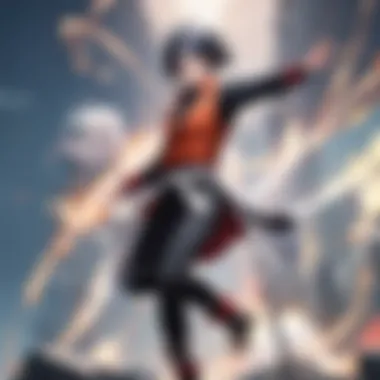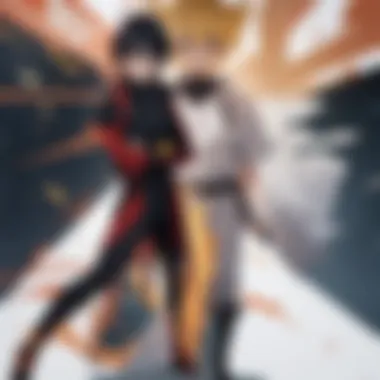Naruto in English: A Comprehensive Analysis


Prologue to the Series
The world of Naruto is rich and detailed, rooted deeply in the shōnen genre. Originally created as a manga by Masashi Kishimoto, the series launched in 1999 and quickly gained a substantial following. It later transitioned into an anime adaptation, brought to life by Studio Pierrot, which first aired in 2002. This narrative not only weaves a tale of ninja battles and camaraderie but also touches on personal growth, resilience, and the quest for identity. The characters are multidimensional, each embodying complex stories that engage the audience on various levels.
Naruto revolves around Naruto Uzumaki, a young ninja with dreams of becoming the Hokage, the leader of his village. However, his path is fraught with challenges, primarily stemming from his isolation due to the Nine-Tails fox sealed within him. Other notable characters include Sasuke Uchiha, Naruto's rival, and Sakura Haruno, his teammate. Their interactions and evolutions throughout the story highlight the themes of friendship and rivalry, making the narrative compelling.
The significance of Naruto extends beyond its plot. It became a trendsetter in the anime community, influencing many other works and forming a cornerstone of modern anime culture. Its reception has been overwhelmingly positive, both in Japan and in English-speaking demographics, where it caught the attention of a global audience. Fans appreciate the series not just for its action but also for its emotional depth and thematic richness.
In exploring Naruto in English, we unfold layers of adaptation and interpretation, delving into how it resonates with different cultures. Each element, from the voices to the localization decisions, shapes the viewing experience.
"The adaptability of Naruto showcases its universal themes, transcending cultural contexts while remaining true to its origins."
With this analysis, we will comprehensively explore various facets of this enduring series.
Prelims to Naruto
The anime and manga series Naruto holds a significant place in the realm of popular culture, especially among anime and manga enthusiasts. This section serves to frame the discussion surrounding this influential series. Understanding Naruto entails acknowledging its impact not just as a form of entertainment, but also as a cultural phenomenon that resonates with themes of perseverance, friendship, and self-discovery. The series presents a rich tapestry of characters and narratives that engage viewers and readers alike.
Delving into the series’ origins and evolution allows us to appreciate the art form it represents. It challenges the conventional boundaries of storytelling in animated formats, inviting audiences to explore deeper philosophical and social themes. By engaging with Naruto, one learns about the significance of its narrative structure and character development, which have been pivotal in shaping the perceptions of anime in English-speaking demographics.
Understanding the importance of Naruto also demands a closer examination of its translation and adaptation processes. The journey of this series from Japan to the English-speaking world manifests challenges and insights that enrich our comprehension. The relevance of linguistic choices cannot be understated, as translation can either preserve or distort the original intent of the creator. Thus, analyzing Naruto through both its original lens and its English adaptations reveals layers of complexity worthy of discussion.
Overview of Naruto
Naruto is a Japanese manga series created by Masashi Kishimoto, first serialized in Shueisha's Weekly Shōnen Jump magazine from 1999 to 2014. The story follows Naruto Uzumaki, a young ninja seeking acknowledgment from his peers while pursuing his dream to become the strongest leader or Hokage of his village. This overarching narrative conveys profound messages about ambition, identity, and resilience.
The appeal of Naruto extends beyond its storyline. The series intertwines numerous elements, including diverse jutsu (ninja techniques), unique character arcs, and a compelling world rich in history. The art style complements the narrative, enhancing emotional engagement.
With over 250 million copies sold worldwide, the cultural footprint of Naruto is undeniable. Its popularity sparked merchandise, spin-offs, and adaptations, including an anime series that aired from 2002 to 2017, and a sequel series titled Boruto: Naruto Next Generations. This enduring legacy solidifies Naruto as a cornerstone of both manga and anime culture.
The Journey of the Series
The journey of Naruto from a manga to a widely recognized media franchise illustrates the global influence of anime. Originating in Japan, the series began its quest with its initial manga chapters, captivating a dedicated audience quickly. Its adaptation into an anime series further expanded its reach and solidified its place in popular media.
As Naruto made its way to English-speaking audiences, it underwent significant transformations. Localization teams had the task of translating not just the dialogue but also cultural references, humor, and the emotional undertones of the narrative. The subtleties of Japanese culture presented a challenge that required careful consideration in order to maintain the spirit of the story when translated.
In addition to translation challenges, the series also witnessed diverse adaptations in both dubbing and subbing. Each method of localization brought its unique perspective and interpretation to characters and scenes. To understand the nuances involved in the adaptation of Naruto, one must acknowledge the varying approaches taken by different localization teams, as well as the reception these adaptations received from fans.
Ultimately, the journey of Naruto showcases its ability to transcend geographical and linguistic boundaries. This narrative exploration forms a key part of the conversation surrounding the adaptation of anime into English, illustrating how complex cultural narratives engage and resonate with audiences worldwide.
Translation and Adaptation


The translation and adaptation of 'Naruto' for English-speaking audiences holds significant weight in understanding the series. Translation goes beyond the mere conversion of words; it reflects cultural nuances and emotional weight. The needs of the audience influence choices made by translators. Each decision made during the process shapes perceptions and emotional connections with characters and themes.
Adaptation is equally essential. It involves altering scenes or dialogues to fit the cultural context of the audience. This allows the essence of the narrative to resonate more deeply. Through adaptation, creators help bridge the gap between vastly different cultural backgrounds. The adjustments made can enhance or diminish the original message. Understanding this process is crucial for fans and scholars alike.
Translation Challenges
Translating 'Naruto' involves several challenges. One significant aspect is maintaining the original tone while adapting to a new language. For instance, some jokes or references may lose their impact if directly translated. Cultural references also pose difficulties since they might not have direct equivalents in English.
Moreover, the complexity of character dialogue adds another layer. Characters in 'Naruto' are often rich with distinct personalities expressed through their speech. Capturing these traits in English without losing their essence is a delicate balance. The nuances in social hierarchy and relationships among characters must also be reflected accurately.
Dubbing vs. Subbing
The choice between dubbing and subbing is central to how audiences experience 'Naruto' in English. Each method brings its own set of advantages and disadvantages.
Pros and Cons of Dubbing
Dubbing allows viewers to immerse themselves without the barrier of reading subtitles. This can create a more engaging experience, especially for those unfamiliar with reading translations quickly. Voice acting can enhance character portrayals, bringing life to emotions in a way that visuals alone might not convey. However, one must consider that dub often changes dialogue for lip-syncing, which might alter original intentions.
Critics of dubbing argue that it sometimes lacks the intricacies, stressing that the original voice actors offer a unique charm. Misinterpretations may occur, leading to diluted meanings or reduced emotional impact. Despite these drawbacks, dubbing remains a popular option for many fans, particularly for casual viewers.
Pros and Cons of Subbing
Subbing retains the original audio, allowing audiences to hear the characters' true voices and the emotions intended by the creators. This can foster a more authentic connection to the original material. Subtitles also tend to keep the original dialogue intact. This direct translation preserves cultural references and humor better, appealing to dedicated fans seeking the authentic experience.
Nevertheless, subbing requires the audience to read continuously, which can detract from their focus on the visual elements. Some may find it challenging to follow along, especially in fast-paced scenes. Additionally, nuances in translation can lead to subtle misunderstandings if not done carefully. Nevertheless, many consider subbing to be superior for its fidelity to the source material.
The landscape of adapting anime for English audiences showcases the ongoing dialogue between retention and interpretation.
Character Dynamics in English
Character dynamics play a crucial role in understanding the depth of any narrative, and in the case of Naruto, this is particularly true. The interactions between characters not only drive the plot forward but also reveal the inherent themes and emotional undercurrents of the series. When analyzing Naruto in English, it is essential to consider how character voices contribute to the overall interpretation of their personalities and relationships. This section examines the significance of character voices and the cultural nuances involved in character portrayals, showcasing the unique challenges and advantages present in the English adaptation of this iconic series.
Character Voices and Interpretations
In any animated series, voice actors bring the characters to life. In the English version of Naruto, the talent behind the voice acting shapes how audience members perceive characters. Each voice reflects not only personality traits but also emotional states and growth throughout the series.
For example, the voice of Naruto Uzumaki, provided by Maile Flanagan, captures his journey from an outcast to a respected ninja. The choice of tone and inflection can heavily influence viewers' connection to his character. In comparison, Japanese voice actors like Junko Takeuchi present Naruto in a distinctly different light, with unique emotional nuances that may be lost in translation. This difference highlights how voice interpretation impacts viewer experience.
Equally important is the casting of other notable characters, like Sasuke Uchiha and Sakura Haruno. The performances of Yuri Lowenthal and Kate Higgins, respectively, convey various emotional struggles and rivalries present in Naruto. These dynamics are integral, as they create the foundation of bonds and conflicts that drive the narrative.
Cultural Nuances in Character Portrayals
Cultural elements are embedded within character portrayals. Naruto, originating from Japan, reflects societal norms and values distinct to its culture. When adapted into English, these cultural references must be navigated with careful precision.


Certain traits admired in Japanese culture, such as humility or respect for elders, may not resonate as strongly within Western audiences. Hence, character portrayals sometimes shift to align more with the expectations of English viewers. The adaptation process can strip some characters of their original intentions, leading to potential misunderstandings.
Consider the character of Sakura Haruno. In Japan, her character evolves as a fierce warrior but is also criticized for her initial portrayal as overly dependent on male figures. The English adaptation attempts to bridge this gap by emphasizing her growth, resilience, and independence while still grappling with these cultural expectations.
In addition, dialogue translated into English can unintentionally alter the character's depth. Subtle humor or cultural references may not carry over effectively, often leading to simplified or modified lines that can change the character dynamics substantially.
"In understanding character dynamics, it is vital to recognize how voice performances and cultural contexts shape audience perceptions of these characters, ultimately impacting their connections to the narrative as a whole."
This exploration of character voices and cultural nuances is essential for fans and scholars alike in appreciating the depth of Naruto in the English context. By understanding these dynamics, one can gain a fuller appreciation of how the series has transcended its Japanese roots and become a global phenomenon.
Thematic Elements of Naruto in English
Understanding the thematic elements of Naruto is crucial for comprehending the series' broad appeal and cultural significance within English-speaking audiences. This section will explore core themes such as friendship, rivalry, morality, and redemption that resonate deeply with viewers. Each theme not only contributes to character development but also to the overall narrative structure. These themes become vital as they provide viewers with relatable experiences, making the series engaging on multiple levels.
Themes of Friendship and Rivalry
Friendship and rivalry play significant roles in Naruto. The series deftly illustrates how relationships shape the characters. Naruto Uzumaki, the protagonist, has a deep desire for companionship, stemming from his isolated childhood. His relationships are foundational to his growth. The bond between Naruto and Sasuke Uchiha exemplifies this. Their rivalry fuels them to grow stronger and navigate their paths.
In many instances, conflicts arise from their differing views. Naruto believes in open communication and understanding, while Sasuke often opts for solitary strength. This duality illustrates contrasting philosophies on personal growth.
Moreover, these themes parallel typical challenges faced in real life. Viewers can see reflections of their struggles with friendships and rivalries. Naruto emphasizes the importance of forgiveness and understanding, thus promoting values that resonate universally.
Morality and Redemption
Another prominent theme in Naruto is morality and redemption. Characters grapple with choices that have significant impacts on their lives and those around them. The series challenges moral boundaries frequently. For instance, characters such as Itachi Uchiha faced harsh choices for what they believed was for the greater good. This raises questions regarding the nature of justice and personal sacrifice.
Redemption arcs contribute significantly to character depth. Naruto serves as a catalyst for change, helping others recognize their mistakes and seek atonement. His journey illustrates that no one is beyond redemption; it is a powerful message about understanding flaws and striving to improve.
Overall, the themes of morality and redemption underscore the complexity of human nature and the potential for growth through adversity. These narratives invite viewers to consider their moral compass and personal growth, creating a deep, reflective viewing experience.
"Naruto is not just a tale about ninjas but a rich tapestry of cultural lessons about growth, friendship, and redemption. This makes it resonate on profound levels."
Cultural Impact and Reception
The cultural impact of Naruto cannot be overstated. It has left a significant mark on both the anime industry and popular culture in general. This section aims to explore how Naruto has influenced Western animation and the way it fostered a community of dedicated fans.
Influence on Western Animation
In the early 2000s, Naruto became a prominent entry in the Western animation landscape. Its unique blend of storytelling, character development, and emotional depth resonated with audiences. This show introduced many viewers to the world of anime, effectively broadening the appeal of Japanese media in the West. The artistry of Naruto, combined with its episodic storytelling, set a new standard for character-driven narratives in Western cartoons.
Significantly, Naruto helped pave the way for other anime series like Bleach and One Piece, which followed in its wake. The success of Naruto demonstrated that animated series could tackle complex themes, such as friendship, perseverance, and the struggle for acknowledgment. This change led to more series that incorporated story arcs and extensive world-building, marking a shift in how Western audiences engaged with animation.
Ultimately, Naruto facilitated a cross-cultural exchange. Elements from Naruto, like ninjutsu, became widely recognized in Western pop culture. Video games, merchandise, and references in mainstream media all reflect the lasting influence of the series on Western animation.


Fandom and Community Engagement
The Naruto fandom is large, dedicated, and diverse. This community thrives on social media platforms like Reddit and Facebook, where fans discuss episodes, share fan art, and create theories about characters and plot developments. The ability of Naruto to inspire deep discussions and analysis showcases its significance in contemporary anime culture.
Fans engage in various activities that amplify this sense of belonging. Events like cosplay conventions highlight the creative ways fans embrace their favorite characters. The act of dressing up as a character from Naruto serves as a form of expression and celebration of the series, bridging gaps and creating conversations among different fandoms.
The Naruto fandom exemplifies how a series can become a cultural phenomenon, uniting fans worldwide through shared interests and experiences.
Online forums and websites also serve as platforms for critiques and reviews. These discussions contribute to a richer understanding of the series and its themes. The community's engagement has led to increased visibility for Naruto, ensuring its relevance across generations.
Comparison with the Original Japanese Version
The act of comparing the English and Japanese versions of Naruto provides valuable insight into the cultural and linguistic nuances of the series. As a work that has garnered a global audience, understanding these differences allows fans to appreciate the adaptations made during localization. Such comparisons highlight the complexities involved in conveying emotions, humor, and cultural references from one language to another. They also reveal how these adaptations might alter the viewer's interpretation of character motivations and key plot points.
Key Differences in Dialogue and Context
Dialogue in Naruto often reflects the unique culture of Japan. For instance, certain phrases carry a weight of historical or social significance that may not directly translate into English. This can lead to loss of meaning or intent, as the subtleties embedded in the original Japanese language can be challenging to replicate.
One example can be found in character names and titles. In Japan, characters often address each other with honorifics such as "-san" or "-kun," denoting respect or familiarity. However, these nuances frequently get omitted in the English adaptation, which can lead to misunderstandings regarding relationships and social dynamics between characters.
Additionally, cultural idioms or expressions present distinct challenges. Expressions related to Japanese folklore might be replaced or altered to fit Western contexts. This sometimes results in an adjustment to the humor or emotional tone of specific scenes. Thus, while the story remains intact, certain moments may resonate differently with English-speaking audiences.
Narrative Structure and Pacing
The narrative structure of Naruto sees differences between the original Japanese series and its English adaptation. While the story arc and themes are preserved, the pacing can vary significantly. This stems from the need to condense or expand episodes to suit broadcast standards and audience expectations in different regions.
In some cases, the English version might incorporate filler episodes more liberally. This is often due to the necessity of extending the series to align with the manga's release schedule. Consequently, crucial character development may feel rushed or sidelined, affecting the overall flow of the narrative. On the other hand, certain scenes may receive editing for brevity or clarity, altering their emotional impact and the viewer's connection to the storyline.
In the end, the differences in dialect and structural formats shape the viewer’s experience in significant ways, often making the English version a distinct retelling rather than a direct translation.
As fans navigate both versions, they gain a deeper appreciation for the original storytelling methods and the cultural heritage behind the characters and their journeys. Understanding these aspects is vital for any devoted anime and manga enthusiast, enriching their engagement with Naruto in both its Japanese and English forms.
Culmination: The Future of Naruto in English
As we reflect on the multifaceted journey of Naruto, it is essential to consider its future in the English-speaking world. The significance of this analysis lies not only in understanding past adaptations but also in how Naruto continues to shape cultural discourse and anime engagement. The series has created a vast legacy, influencing both viewers and creators in significant ways.
Legacy and Long-lasting Appeal
The appeal of Naruto transcends generations. Its compelling narrative and relatable character arcs have made it a staple in the anime community. Fans often return to its themes of friendship, perseverance, and self-discovery. The English dub and subtitles have allowed a broader audience to connect with these messages, ensuring the series remains relevant.
Moreover, Naruto has established a strong fandom that actively engages in discussions, fan art, and conventions. The continued production of new content, such as sequels and spin-offs, sustains interest. The legacy is not confined to mere popularity; it reflects how well the series resonates with fundamental human experiences.
Continuing Influence on New Generations
Naruto serves as an entrance point for many into the world of anime. Younger viewers often discover the series via streaming platforms or through recommendations from older fans. This organic exposure fosters a new generation of enthusiasts who appreciate the rich storytelling and character development that Naruto offers.
With the rise of social media platforms, discussions around Naruto are more vibrant than ever. Fans share interpretations, fan theories, and artworks, enriching the community. The reach of popular platforms like Reddit and Facebook enhances this interaction, creating space for even deeper analysis and community engagement.
"The future will undoubtedly see Naruto continue to influence not just viewers, but also new creations within the anime industry."















